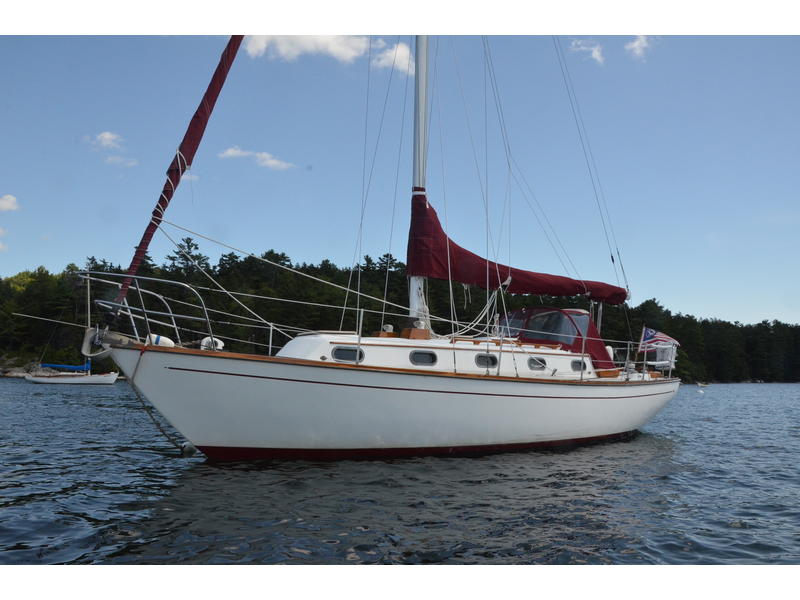Cape Dory is perhaps best known for the Cape Dory Typhoon, a salty little eighteen and a half foot sloop designed by Carl Alberg and built between 1967 and 1986. I mention this only because the Typhoon became the standard by which nearly all future Cape Dory boats were designed and constructed. All were traditional, sturdy, conservative designs that were well mannered under most conditions. Most were designed by the late Carl Alberg, following the design example of the Typhoon. The Cape Dory 33 is no exception.
Introduced in 1980, the Cape Dory 33 was most likely intended to fill the need of loyal owners of the very popular Cape Dory 30 wanting to move up to a slightly larger boat yet not wanting the size or expense of the company’s 36’ model. Between 1980 and 1985, 124 Cape Dory 33s were constructed. In 1986 there were slight modifications to the cockpit and interior that resulted in the Cape Dory 330 model. An additional 20 or so of this model were built between 1986 and 1989. Cape Dory ceased regular production in 1991.
As previously mentioned, the Cape Dory 33 is sturdily constructed. The hull is built of a solid laminate of plastic resin and fiberglass cloth. The laminate thickness is greater than average for a production sailboat in this size range. The hull is supported by fiberglass encapsulated structural members, full and partial transverse bulkheads and molded fiberglass liners. Attachments and secondary bonding are generally sound.
Decks are constructed of a composite of fiberglass, resin and balsa wood core. Moisture saturation of the core material and delamination are not uncommon, particularly along the side decks in the area of the chain plates and rigging attachments. Cape Dory used a mild steel bracket for the attachment of the lower shroud chain plates, and that is subject to considerable corrosion and wasting if leaks persist where chain plates pass through the deck. These areas are difficult to inspect due to the installation of fiberglass hull liners, and careful attention must be paid to prevent serious problems. Other problems commonly found as these boats age include water saturation and delamination of the rudders and moderate osmotic blistering.
Depending on the year, the CD 33 was either powered by a 23 Hp Volvo or a 24 Hp Universal marine diesel engine. Either is close enough to my 2 Hp per 1,000 lbs. of displacement rule of thumb to provide for adequate performance under power. Parts and service are readily available for either engine, and properly serviced and maintained, either should provide several thousand hours of dependable operation.
The interior of the Cape Dory 33 has only one modification from what I’ll call a"Plan - A" standard interior. That one modification involves the standard V-Berth configuration. That of the CD 33 has been designed as a single berth resembling an"L". The berth may be extended and converted to a double with some effort, but I would prefer to have the standard double"V" configuration. The forward berth is followed by a port side head and starboard lockers. The main saloon is next with opposing settees followed by a starboard side navigation station, quarter berth, and a port side galley. The interior of the 330 model has a true V-Berth cabin forward followed by a starboard side head with shower. There are port and starboard side settees in the main saloon pushed a little further outboard for a more open feel, and there is a large galley which spans the after portion of the cabin.
With a waterline length of 24’ 6" and a displacement of 13,300 lbs., the displacement length ratio (D/L) of the Cape Dory 33 works out to be a hefty 404. The sail area displacement ratio (SA/D), on the other hand, is a conservative 15.6. To put these numbers into perspective, the respective numbers for a Westsail 32 are 419 D/L and 14.6 SA/D. A modern, conservative production boat in this size range would likely have a D/L in the range of 230 to 260 and a SA/D in the range of 17 to 18.
The CD 33 was offered with either a sloop or a cutter rig, and while the cutter has some advantages in heavy weather and offshore conditions, the sloop, with a large genoa, is the better choice for the Chesapeake. No one should buy a Cape Dory 33 looking for flashy speed, and when the wind lightens up, it’s usually time to bring out the iron genoa. The CD 33 shows her true heritage in moderate to heavy air. She is initially a little tender, but firms up nicely at about 15 degrees angle of heel. With a full keel and attached rudder she tracks well both on and off the wind. When weather helm gets a little heavy, it’s time to shorten sail, and as with any boat, particularly those with substantial overhangs, it is critical (for best performance) to keep excessive weights out of the ends for best performance.
I must admit that for the sailing conditions commonly found on the Chesapeake Bay, the Cape Dory 33 wouldn’t be on my short list of 33 footers. If, on the other hand, you’re absolutely sold on conservative design and solid construction and your cruising plans include coastal and offshore passages exposed to all conditions, the stock of CD 33 rises considerably. All Cape Dorys have a loyal following, and they tend to retain their value quite well. There are several active Cape Dory owners’ associations.
Reviewed in the November 1998 issue of SpinSheet Magazine





